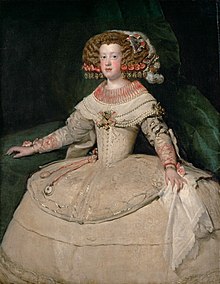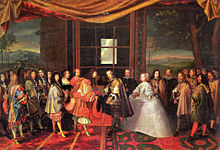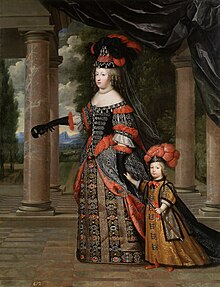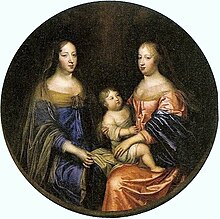What Happened to Marie-thãƒâ©rãƒâ¨se, the Wife of Louis Xiv
| Maria Theresa of Spain | |||||
|---|---|---|---|---|---|
 Portrait by Jean Nocret | |||||
| Queen espoused of France | |||||
| Tenure | 9 June 1660 – 30 July 1683 | ||||
| Born | (1638-09-x)10 September 1638 El Escorial, Spain | ||||
| Died | 30 July 1683(1683-07-30) (anile 44) Versailles, France | ||||
| Burying | Basilica of St Denis | ||||
| Spouse | Louis XIV of French republic (1000. 1660) | ||||
| Issue more... |
| ||||
| |||||
| Business firm | Habsburg | ||||
| Begetter | Philip Iv of Espana | ||||
| Mother | Elisabeth of France | ||||
| Religion | Roman Catholicism | ||||
| Signature | | ||||
Maria Theresa of Spain (Castilian: María Teresa de Austria; French: Marie-Thérèse d'Autriche; 10 September 1638 – 30 July 1683), was past nascency Infanta of Kingdom of spain and Portugal (until 1640) and Archduchess of Austria as member of the Spanish branch of the House of Habsburg and past union Queen of France and Navarre.
Her marriage in 1660 to King Louis XIV, her double first cousin, was made with the purpose of ending the lengthy war between French republic and Spain. Famed for her virtue and piety, she saw five of her six children die in early babyhood, and is frequently viewed as an object of pity in historical accounts of her hubby's reign, since she was often neglected by the court.
Without whatsoever political influence in the French court or government (except briefly in 1672, when she was named regent during her husband's absence during the Franco-Dutch War),[1] she died at the early historic period of 44 from complications from an abscess on her arm.
Her grandson Philip V inherited the Castilian throne in 1700 subsequently the death of her younger half-brother, Charles II, and the War of the Spanish Succession, founding the Spanish branch of the House of Bourbon, which has reigned with some break until present time.
Early on life [edit]


Infanta Maria Theresa by Velázquez, 1653. Her hairstyle and wearing apparel with wide panniers were pop in Kingdom of spain.

Built-in an Infanta of Kingdom of spain and Portugal at the Majestic Monastery of El Escorial, she was the girl of Philip Four & III, and his wife Elisabeth of France, who died when Maria Theresa was six years old. As a member of the House of Austria, Maria Theresa was entitled to utilise the title Archduchess of Austria. Elizabeth of France chose Sainte Thérèse to protect her daughter, the youngest of a series of precocious births. She gave her the name Thérèse to protect her, namely Marie-Thérèse.[2] She was known in Spain equally María Teresa de Austria and in French republic as Marie-Thérèse d'Autriche.
She was raised by the imperial governess Luisa Magdalena de Jesus.[3] The religious didactics of Marie-Thérèse was carried out by Juan de Palma,[4] commissioner of the Indies who had been the manager of Elizabeth of France, was charged by Philippe IV to look after his daughter, as he had looked afterward the mother of the princess. Finally, in afterwards times information technology was Father Vasquez, a human recognized in Espana for existence highly educated and of great virtue; it was he who had been entrusted with the spiritual instruction of the young Infanta.[5]
Unlike French republic, the kingdom of spain had no Salic Police, so information technology was possible for a female to presume the throne. When Maria Theresa'due south blood brother Balthasar Charles died in 1646, she became heir presumptive to the vast Spanish Empire and remained such until the nascence of her brother Philip Prospero, in 1657. She was briefly heir presumptive once again between 1–six November 1661, following the death of Prince Philip and until the birth of Prince Charles, who would after inherit the thrones of Spain every bit Charles II.
In 1658, as state of war with France began to wind down, a spousal relationship between the regal families of Spain and French republic was proposed as a means to secure peace. Maria Theresa and the French king were double first cousins: Louis XIV's begetter was Louis XIII of French republic, who was the brother of Maria Theresa'southward mother, while her father was brother to Anne of Austria, Louis Fourteen's female parent. Spanish procrastination led to a scheme in which France'south prime number government minister, Fundamental Mazarin, pretended to seek a union for his primary with Margaret Yolande of Savoy.[6] When Philip Iv of Kingdom of spain heard of a meeting at Lyon between the Houses of France and Savoy in November 1658, he reputedly exclaimed of the Franco-Savoyard union that "it cannot exist, and will not be". Philip then sent a special envoy to the French court to open negotiations for peace and a imperial matrimony.
Union [edit]

The negotiations for the marriage contract were intense. Eager to prevent a marriage of the two countries or crowns, especially i in which Spain would be subservient to French republic, the diplomats sought to include a renunciation clause that would deprive Maria Theresa and her children of any rights to the Castilian succession. This was eventually done but, by the skill of Mazarin and his French diplomats, the renunciation and its validity were fabricated conditional upon the payment of a large dowry. As it turned out, Spain, impoverished and bankrupt after decades of war, was unable to pay such a dowry, and France never received the agreed upon sum of 500,000 écus.[seven]
A marriage by proxy to the French king was held in Fuenterrabia.[8] Her father and the entire Castilian court accompanied the bride to the Island of Pheasants on the border in the Bidassoa river, where Louis and his court met her in the meeting on the Isle of Pheasants on 7 June 1660, and she entered French republic. On 9 June the marriage took place in Saint-Jean-de-Luz at the recently rebuilt church of Saint Jean the Baptist.[nine] Later the wedding, Louis wanted to consummate the spousal relationship as quickly every bit possible.[10] The new queen's mother-in-law (and aunt) arranged a private consummation instead of the public one that was the custom.[ citation needed ]


Queen Marie Thérèse and her son the Dauphin of France, dated circa 1663 by Charles Beaubrun
Queen [edit]

2 queens of French republic: Anne of Austria with her niece and daughter-in-law, Maria Theresa, and the latter's son Louis
On 26 August 1660, the newlyweds made the traditional Joyous Entry into Paris. Louis was faithful to his wife for the starting time year of their matrimony, commanding the Grand Maréchal du Logis that "the Queen and himself were never to be set autonomously, no thing how small the business firm in which they might exist lodging".
Maria Theresa was very fortunate to have found a friend at court in her mother in law, unlike many princesses in foreign lands. She continued to spend much of her free fourth dimension playing cards and gambling, as she had no interest in politics or literature. Consequently, she was viewed as not fully playing the part of queen designated to her by her matrimony. But more importantly, she became significant in early 1661, and a long-awaited son was born on i Nov 1661.
The first time Maria Theresa e'er saw the Palace of Versailles was on 25 Oct 1660. At that time, it was just a minor royal residence that had been Louis Xiii's hunting lodge not far from Paris. Later, the first building entrada (1664–1668) commenced with the Plaisirs de l'Île enchantée of 1664, a week-long celebration at Versailles ostensibly held in honour of France's two queens, Louis XIV'south female parent and wife, merely exposed Louise de La Vallière'south role as the king's maîtresse-en-titre. The celebration of the Plaisirs de 50'Île enchantée is frequently regarded as a prelude to the War of Devolution, which Louis waged against Spain. The first building campaign witnessed alterations in the château and gardens in lodge to accommodate the 600 guests invited to the celebration.
As fourth dimension passed, Maria Theresa too came to tolerate her married man's prolonged infidelity with Françoise-Athénaïs, Marquise de Montespan. The king left her to her own devices, yet reprimanded Madame de Montespan when her behaviour at court also flagrantly disrespected the queen's position.
Later, the governess of Montespan's illegitimate children by the king, Madame de Maintenon, came to supercede her mistress in the king's angel. At first she resisted the king's advances and encouraged him to bestow more attending on his long-neglected wife, a thoughtfulness which Maria Theresa repaid with warmth toward the new favourite. After the queen'south death, Maintenon would go the king'due south 2nd, although officially secret, wife.
There have long been rumours that Maria Theresa had an illegitimate daughter, Louise Marie Thérèse (The Black Nun of Moret).
Maria Theresa played little role in political affairs except for the years 1667, 1672, and 1678, during which she acted every bit regent while her married man was abroad on campaigns on the frontier.
Expiry [edit]

During the last week of July 1683, Maria Theresa fell ill and, as her illness worsened, her husband ordered for the sacraments to be kept nearby. She died a painful decease on 30 July 1683, at Versailles. Upon her death, Louis XIV said: "This is the start chagrin she has always given me."[11] For the k funeral ceremony, Marc-Antoine Charpentier composed dramatic motets H.409, H.189, H.331 and Jean-Baptiste Lully his Dies irae. The funeral prayer was by Bossuet.
Of her vi children, only one survived her, Louis, le M Dauphin , the oldest one, who died in 1711. I of her younger grandsons eventually inherited her claim to the Castilian throne to become Male monarch Philip V of Spain in 1700.
Effect [edit]
| Proper noun | Nativity | Death | Notes |
|---|---|---|---|
| Maria Theresa of Republic of austria with Louis Xiv of French republic | |||
| Louis, Grand Dauphin | one Nov 1661 | 14 April 1711 | Dauphin of France from 1661–1711. Begetter of Louis, Dauphin of France (1682–1712), Philip V of Spain and Charles, Duke of Drupe (1686–1714). |
| Anne-Élisabeth of France | 18 November 1662 | 30 December 1662 | |
| Marie-Anne of France | 16 November 1664 | 26 Dec 1664 | |
| Marie-Thérèse of France | 2 January 1667 | 1 March 1672 | Known as Madame Royale and la Petite Madame. |
| Philippe Charles, Duke of Anjou | five Baronial 1668 | 10 July 1671 | |
| Louis François, Duke of Anjou | 14 June 1672 | 4 November 1672 | |
Ancestry [edit]
References [edit]
- ^ Marie-Thérèse d'Autriche in: www.chateauversailles.fr [retrieved 23 Nov 2016].
- ^ Duclos, Henri (1815-1900) Auteur du texte (1869). Madame de La Vallière et Marie-Thérèse d'Autriche, femme de Louis Fourteen : avec pièces et documents inédits / par M. l'abbé H. Duclos,... (in French). p. half dozen.
- ^ "Luisa Enríquez Manrique de Lara | Existent Academia de la Historia".
- ^ "Juan de Palma | Real Academia de la Historia". dbe.rah.es . Retrieved 2022-04-04 .
- ^ Duclos, Henri (1815-1900) Auteur du texte (1869). Madame de La Vallière et Marie-Thérèse d'Autriche, femme de Louis XIV : avec pièces et documents inédits / par M. fifty'abbé H. Duclos,... (in French). p. 17.
- ^ Wolf 1968, p. 99.
- ^ Wolf 1968, p. 117.
- ^ Wolf 1968, p. 121.
- ^ Wolf 1968, p. 123.
- ^ Wolf 1968, p. 124.
- ^ Wolf 1968, p. 328.
Bibliography [edit]
- Duclos, Henri-Louis (1869). Madame de La Vallière et Marie-Thérèse d'Autriche, femme de Louis Fourteen : avec pièces et documents inédits (in French). Paris.
Sources [edit]
- Wolf, John B. (1968). Louis XIV. Due west.W. Norton & Company, Inc.
- This article incorporates text from a publication now in the public domain:Chisholm, Hugh, ed. (1911). "Marie Thérèse". Encyclopædia Britannica. Vol. 17 (11th ed.). Cambridge University Press. p. 715.
External links [edit]
-
 Media related to Marie Thérèse of Austria at Wikimedia Commons
Media related to Marie Thérèse of Austria at Wikimedia Commons
Source: https://en.wikipedia.org/wiki/Maria_Theresa_of_Spain
0 Response to "What Happened to Marie-thãƒâ©rãƒâ¨se, the Wife of Louis Xiv"
Post a Comment